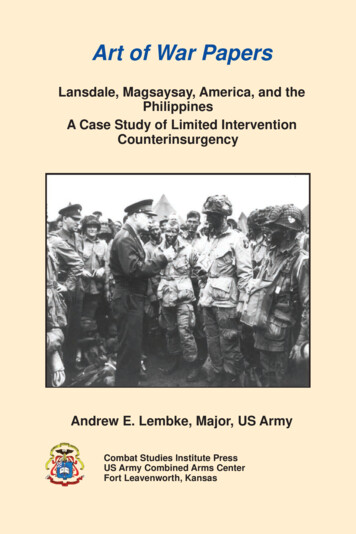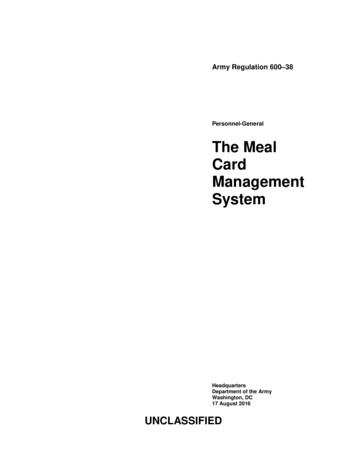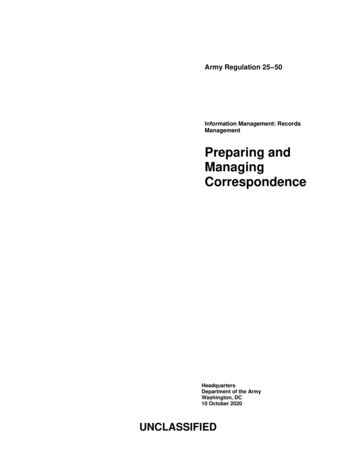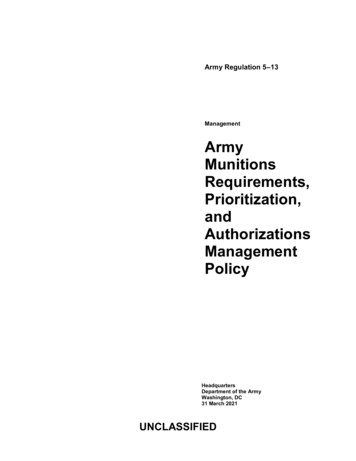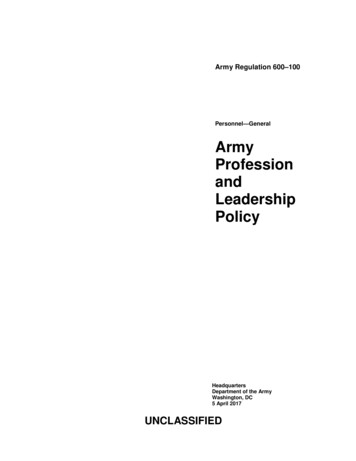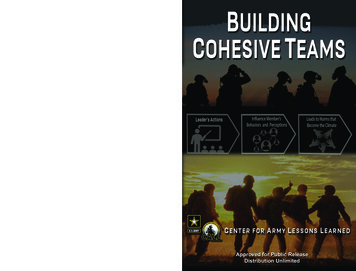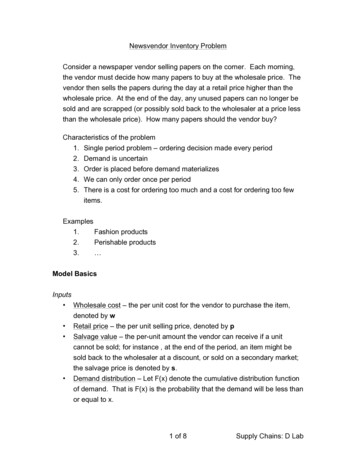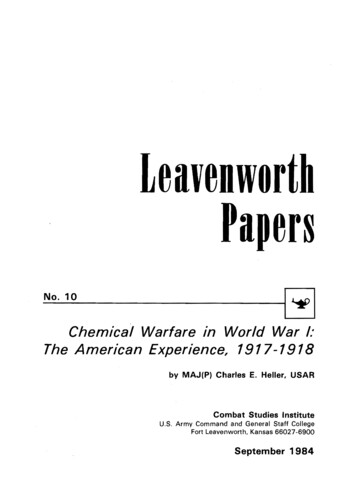
Transcription
LeavenworthPapersN o. 1 0 1 1Chemical Warfare in World War I:The American Experience, 1917-1918by MAJ(P) Charles E. Heller, USARCombat Studies InstituteU.S. Army Command and General Staff CollegeFort Leavenworth, Kansas 66027-6900September 1984
.----------FOREWORD---------This Leavenworth Paper chronicles the introduction of chemical agents in World War I, theU.S. Army's tentative preparations for gas warfare prior to and after American entry into the war.and the AEF experience with gas on the Western Front.Chemical warfare affected tactics and almost changed the outcome of World War I. The overwhelming success of the first use of gas caught both sides by surprise. Fortunately,. the pace ofhostilities permitted the Allies to develop a suitable defense to German gas attacks and eventuallyto field a considerable offensive chemical capability. Nonetheless, from the introduction of chemicalwarfare in early 1915 until Armistice Day in November, 1918, the Allies were usually one stepbehind their German counterparts in the development of gas doctrine and the employment of gastactics and procedures.In his final report to Congress on World War I, General John J. Pershing expressed the sentiment of contemporary senior officers when he said, "Whether or not gas will be employed infuture wars is a matter of conjecture, but the effect is so deadly to the unprepared that we cannever afford to neglect the question." General Pershing was the last American field commanderactually to confront chemical agents on the battlefield. Today, in light of a significant Soviet chemicalthreat and solid evidence of chemical warfare in Southeast and Southwest Asia, it is by no meanscertain he will retain that distinction.Over 50 percent of the Total Army's Chemical Corps assets are located within the UnitedStates Army Reserve. This Leavenworth Paper was prepared by the USAA Staff Officer servingwith the Combat Studies Institute, USACGSC, after a number of requests from USAA ChemicalCorps officers for a historical study on the nature of chemical warfare in World War I. In fulfillingthe needs of the USAA. this Leavenworth Paper also meets the needs of the Total Army in itspreparations to fight, if necessary, on a battlefield where chemical agents might be employed.CARL E. VUONOLieutenant General, USACommandantDirectorCOL Louis D. f. frascheJohn F. Morrison Professor of Military HistoryDr. Bruce W. MenningCurriculum Supervisorl TC(P) Michael L ChaseOperations Officerl TC Patrick H. GormanCAC Historical OfficeDr. John W. Partin, CAC HistorianOr. William G. Robertson, Deputy CAC HistorianDirector, Fort Leavenworth MuseumDr. John P. langellierResearch CommitteeLTC Gary L. Bounds, Chiefl TC Gary H. WadeOr. Rober! H. BerlinMAJ(Pi Charles E. Heller. USARDr. George GawrychMAJ Scott McM1chaelDr. Gary BjorgeTeaching Committeel TC John A. Hixson, ChiefLTC George l. TupaDr. Robert E. BaumannMAJ{P) David R. DurrDr. Jerold E. Bro.vnMAJ(P) Roy R. Stephensonllr. Christopher R GabelMAJ Roger CirilloDr. Joseph GlatthaarSFC Robert R. CordellMilitary History Education Committeel TC Michael E. Hall, ChiefMAJ George J. Mordica, IIDr. Jack J. GiftordCPT(P) Don M. Prewitt, ARNGDr. Larry RobertsHistorical Services CommitteeDr. !Jlwrence A. Yates, ChiefElizabeth R. Snoke, LibrarianMarilyn A. Edwards, EditorDonald Gilmore, EditorCarolyn Brendsel, EditorSlaffSFC Danny G. CarlsonSP5 Patricia ClowersClara l. RhoadesCynthia l. TeareSharon E. TorresCarolyn D. Conway---1 1Leavenworth Papers are published by theCombat Studies Institute, U.S. Army Commandand General Staff College, Fort Leavenworth,KS 66027. The views expressed in this publication are those of the author and notnecessarily those of the Department of Defenseor any element thereof. Leavenworth Papersare available from the Superintendent ofDocuments, U.S. Government Office, Washington, DC 20402.Leavenworth Papers US ISSN 0195 3451
No. 10Chemical Warfare in World War I:The American Experience, 1917-1918by MAJ(P) Charles E. Heller, USARCombat Studies InstituteU.S. Army Command and General Staff CollegeFort Leavenworth, Kansas 66027-6900September 1984
Library of Congress Cataloging in Publication DataHeller, Charles E., 1943Chemical warfare in World War I.(Leavenworth papers, ISSN 0195-3451 ; no. 10)"September 1984."Bibliography: p.1. World War, 1914-1918--Chemical warfare.2. World War, 1914-1918--United States. 3. Chemicalwarfare--United States--History--20th century. I. Title.II. Series.940.4' 14484-28527UG447.H39 1985
c o n te n t s ---- -- -11"'*11Illustrations . . vTables . ,', . . viiIntroduction . . . . . . . . . . . . . . . . . . . . . . . . . . . . . . . . . . . . . . . . . . . . . . . . . . . . . . . . . . . . 11. The Introduction of Gas Warfare in World War I . . . . . . . . . . . . . . . . . . . 32. The Europeans Face Chemicals on the BattlE field, 1915-1918 . . . . . . 133. The U.S. Army's Response to Chemical Warfare, 1915-1917 . 354. The AEF Organizes for Chemical Warfare . 475. "The Quick and the Dead": The AEF on the Chemical Battlefield . . 616. "We Can Never Afford to Neglect the Question" . 91Notes . 95Bibliography . 103For sale by the Superintendent or Documents, U.S. Government Printing O!Ilce, Washington, D.C. 20402iii
ll lu s tr a t io n s .I IMaps1. The stabilized Western Front, 1915 . . . . . . . . . . . . . . . . . . . . . . . . 52. Ypres sector in Belgium, 22 April-24 May 1915 . . . . . . . . . . . . . . . . . . . . . 93. Varicolored zones of German gas fired in support ofa crossing of the Dvina River before Riga,Eastern Front, 1 September 1917 . 264. German gas shell bombardment of Armentiereson 9 April 1918 . 285. The German spring offensives of 1918 wereheavily supported by a variety of gases . 29Figures1. Side view of gas cylinder emplacement . 142. Organization of the Gas Service, AEF, 1917 . 493. U.S. Gas Regiment, company organization, 1917 . 584. Entrance, gas-proof dugout . 72v
T a b le s ----1[ 1Summary of markings for chemical shell andproperties of most common gases . . . . . . . . . . . . . . . . . . . . . . . . . . . . . . . . . . . . 152. Hospitalized casualties . 921.vii
ln t ro d u c t io n --------ij ]The combat experience of World War I provided the U.S. Army with itsfirst significant exposure to chemical warfare. The purpose of this paper isto show how the Army prepared for this kind of warfare and how soldiersin the American Expeditionary Forces (AEF), from generals to doughboys,adapted or failed to adapt to fighting a war in which chemical weaponsplayed a prominent role. Because no one AEF division experienced everyfacet of gas warfare, the study will examine information pertaining to manyunits in order to give a more complete picture of the phenomenon.In World War I terms, chemical warfare included not only gas, butliquid flammable material, thermite, and smoke (all of which are relevantto the modern battlefield). This study will deal only with what participantsreferred to as "chemicals," "gases," or "war gases." These included realgases such as phosgene and chlorine, and also weapons that, while referredto as gases, were in fact vaporized liquids (mustard gas, for example) orfinely ground solids. In this study the terms "chemical agent" and "gas"will be used interchangeably. Smoke will be discussed, but only as a rusede guerre for gas; liquid flame and thermite will not be covered. Becausemost of the U.S. experience was on the Western Front, that theater of thewar will receive detailed treatment.Despite technological advances in chemical warfare since 1918, manylessons learned on the battlefields of World War I are valid for study today,if only because America's principal antagonist in world affairs, the SovietUnion, appears to be quite willing to employ chemical agents on today'sbattlefield. During the decade of the 1970s persistent accounts of the useof chemical agents by the Russians and their clients caused the U.S.government to pay closer attention to the problem of chemical warfare.Soviet offensive equipment captured by the Israelis in the 1973 October Warcontained filtration systems for survival on a chemical or biological battlefield. Reports from Laos about Vietnamese using a chemical agent called"Yellow Rain" on mountain tribesmen prompted a policy review by U.S.government officials. In December, 1979, the Soviet invasion of Afghanistan,with subsequent reports from Afghan refugees that the invaders were usinggas during combat operations, again forced the U.S. Army to reassess itschemical warfare doctrine. 11
2U.S. intelligence estimates indicate that the Russians have between70,000 and 100,000 chemical warfare troops. Every Soviet line regiment hasa Chemical Defense Company. Present Soviet chemical delivery systemsinclude artillery, mortars, multiple rocket launchers, bombs, air spray, andland mines. The blood, blister, and nerve agents in the Russian chemicalarsenal include mustard gas (a blister agent) and phosgene (a lung injurant)two of the most effective agents used in World War 1. 2There is an abundance of material available for a study of gas warfareduring World War I. Sources include unit reports, the published andunpublished diaries of participants, books written by chemical officers duringthe interwar period, and a number of secondary historical works of morerecent origin. Also, I conducted several interviews with veterans of the FirstWorld War to obtain as accurate a picture as possible of what it was likefor an AEF doughboy to train for, and to live, work, and fight in, a chemicalenvironment. During the war the newly created Chemical Warfare Service(CWS)* did its best to record its activities and report on the use of chemicals.I relied extensively on these records.A number of agencies provided a great deal of assistance to me in thepreparation of this paper, and I would like to acknowledge the staffs of thefollowing institutions: the Technical Library, Chemical Systems Laboratory,Edgewood Area, Aberdeen Proving Ground; U.S. Army Chemical Center andSchool, Fort McClellan, Alabama; National Archives, Washington, D.C.;Military History Institute, Carlisle Barracks, Pennsylvania; and CombinedArms Research Library, U.S. Army Command and General Staff College,Fort Leavenworth, Kansas. I especially want to thank members of the 1stGas Regiment Association for graciously consenting to be interviewed, andLt. Col. Charles M. Wurm, Chemical Corps, CACDA, Fort Leavenworth, forproviding me with a great amount of technical information and advice.Major(P) Charles Heller, USARCombat Studies InstituteU.S. Army Command and General Staff College*The forerunner of the CWS was the Gas Service, set up under AEF General Order 31, 3September 1917. On 11 May 1918, when the CWS was established as a branch of the NationalArmy, the Gas Service became the Overseas Division, CWS.
The Introduction of Gas1w a r fa r e , ·n W o r ld W a r l --tl IOf all the weapons employed in World War I, none stimulated publicrevulsion more than poison gas. The abhorrence of chemical warfare lingeredlong after the Armistice of 11 November 1918. Gas victims continuallyreminded the general public of the effect of chemical weapons, as illustratedby the often repeated story of a veteran's coughing fit being explained bya tap on the chest and an apologetic, "Gas you know."The employment of chemical agents in war, however, did not begin withWorld War I. The earliest recorded incident occurred in the fifth centuryB.C. during one of a series of wars between Athens and Sparta.* 1 Over the·centuries that followed, combatants on several occasions engaged inrudimentary forms of chemical warfare on the battlefield. If by the end ofthe nineteenth century the use of poison gas was still by far the exceptionand not the rule in war, there were in all the great powers a number ofmen who foresaw its widespread use should a general conflagration engulfEurope. 2A concern with poison gas manifested itself at the Hague Conferenceof 1899. One of the agenda items dealt with prohibiting the use of shellsfilled with asphyxiating gas. The proposed ban** eventually passed with onedissenting vote, that of the American representative, Naval Capt. Alfred T.Mahan, who declared that "it was illogical and not demonstrably humaneto be tender about asphyxiating men with gas, when all were prepared toadmit that it was allowable to blow the bottom out of an ironclad atmidnight, throwing four or five hundred men into the sea, to be choked bywater, with scarcely the remotest chance of escape." Secretary of State JohnHay, in his instructions to Mahan, argued that the inventiveness ofAmericans should not be restricted in the development of new weapons.For Hay it made no sense for the United States to deprive itself of theability to use, at some later date, a weapon that might prove to be morehumane and effective than anything then present in the American arsenal. 3*Spartan forces besieging an Athenian city placed a lighted mixture of wood, pitch, andsulfur under the walls. The Spartans hoped the fumes would incapacitate the Athenians sothat they would not be able to resist the assault that followed.**The declaration stated, "The Contracting Powers agree to abstain from the use ofprojectiles the sole object of which is the diffusion of asphyxiating or deleterious gasses."3
4The Hague Conference declaration did not prevent some nations fromdiscussing the use of chemical weapons, and at least one country, France,experimented publicly with gas. The French Army tested a grenade filledwith ethyl bromoacetate, a nontoxic tear, or lachrymatory, agent developedfor use in the suppression of small-arms fire from the concrete casementsthen prevalent in the permanent fortifications that dotted Western Europe.In 1912, French police used 26-mm grenades filled with this agent to capturea notorious gang of Parisian bank robbers. The Germans, unlike the French,did not experiment with chemical agents for military use as such, but atthe outbreak of World War I, Germany's highly advanced dye industry gaveit a sophisticated technological base from which to develop weapons of thisnature. 4When war erupted in August, 1914, everyone from private citizens tothe leaders of the belligerent countries shared a common belief that theeconomies of the European nations would neither survive nor support alengthy war. As a result, the war plans of two key protagonists, Germanyand France, called for a quick, decisive offensive against one another. KaiserWilhelm II of Germany assured his troops that they would be "home beforethe leaves fall." It was not to be. By the end of 1914, the armies on theWestern Front were locked in a deadly form of trench warfare (Map 1),*sustained by the very industrialized economies that, because of theircomplexity and interdependency, had been thought unable to withstand alorig war. 5Unwilling to accept the indecisiveness of trench warfare, army staffson both sides pondered ways to break the deadlock and return to open ormaneuver warfare. Alternatives were proposed, some strategic, others tactical.The British, for example, sought a strategic solution by a seaborne assaultagainst Turkey, an ally of Germany. This attack at Gallipoli in 1915 soughtto open the Dardanelles as the first step toward linking up with Russiaand forcing Turkey out of the war. For a variety of reasons, the plan failed,and the deadlock on the Western Front continued.As their attack at Gallipoli tottered ·to defeat, the British looked to theapplication of tactical innovation at N euve-Chapelle to break the stalemate.On 10 March 1915 British artillery, instead of firing a lengthy bombardmentprior to an attack, as doctrine dictated, let loose a brief but intense barrageon a relatively narrow German trench frontage. The fire was then shiftedto the German rear in order to create a lethal steel curtain that wouldblock reinforcements. To the surprise of everyone, the British infantry quickly*One of the misconceptions surrounding World War I is that there existed a continuous,parallel belt of trenches stretching from the English Channel in the north to the Swiss borderin the south. In fact, in some sectors along the 470-mile Western Front, soldiers occupied shellholes; in other areas, the terrain caused troops to be dispersed in fortified garrisons or strongpoints. Some trenches, as in the British sector of Flanders, were actually sandbagged parapetsrising from marshy lands, where digging any deeper than a foot or two would have broughtwater to the surface. There was one factor, however, that was constant along the entire front.Whether in trenches, shell holes, or strongpoints, daily life offered little more than dull routineand boredom for the men of both sides as they waited for their respective high commands todecide their fate.
5
6overran the German forward positions. The attack failed, though, primarilybecause the high command, viewing it as an experiment, did not havesufficient reserves available to exploit a breakthrough.Germany also searched for ways to break the deadlock and decided ona solution involving gas. Early in the war the Germans kept a wary eyeout for indications that the French were using their 26-mm gas grenades.Apparently, in August, 1914, France did use this chemical weapon, but inopen areas where the gas quickly dispersed with no noticeable effect on theenemy. The French soon discarded the grenades as worthless. At this sametime, stories were appearing in Allied newspapers about a new French liquidexplosive, turpinite. While claiming that this substance gave off lethal fumes,the articles failed to explain that the gas reached a deadly concentrationonly in confined spaces. Still, the Germans were apprehensive and becamealarmed by the deaths of a number of soldiers asphyxiated during a Frenchbombardment, even though a medical team rushed to the scene concludedthat the men died not from poison gas, but from inhaling carbon monoxidefumes while huddled in their dugout. 6In any event such newspaper stories and front-line experiences mayhave spurred the development of war gases by German scientists. Contributing to that effort, chemistry professor Walter N ernst suggested partiallyreplacing the TNT in a 105-mm shrapnel shell with dianisidine chlorosulphonate, an agent known to cause irritation of the mucous membrane.Tlie new filling would serve two purposes: it would conserve TNT and actas a chemical weapon. The German High Command accepted this newweapon, although it is uncertain which of the two purposes it initiallyconsidered more important. On 27 October 1914, 3,000 of these shells fellon British troops near N euve-Chapelle. The soldiers suffered no ill effectsand never suspected they were under chemical attack. The Germanscontinued to experiment with gas because they were convinced the ideahad merit and because intelligence sources could not determine what effectthe shells had had at Neuve-Chapelle. This lack of information on the effectsof gas attacks was a common occurrence throughout the war. 7The Neuve-Chapelle experiment increased the German High Command'sinterest in gas warfare. The German General Staff asked the Kaiser WilhelmInstitute for Physical Chemistry and Electrochemistry in Berlin to investigatethe possibility of using a more effective agent. The only guideline providedby the military was that the Hague declaration of 1899, banning projectilesused exclusively for delivering poison gases, had to be circumvented.Adhering to the letter if not the spirit of the ban, the Germans devised agas shell that also contained an explosive charge for producing a shrapneleffect. The Professor von Tappan who designed the shell also solved twotechnical problems related to emplacing chemicals in an artillery projectile.First, he stabilized the liquid within a shell casing in order to reduce itstumbling in flight, thereby increasing the shell's accuracy and range. Second,to ensure that two extremely reactive chemical substances did not accidentlycombine in the shell casing, von Tappan developed a special shell, designatedthe T-shell by the German Army in his honor. The T-shell was a standard
715-cm howitzer round that contained seven pounds of xylyl bromide and aburster charge for a splinter effect. A lead lining prevented contact betweenthe burster charge and the chemical payload. 8The German High Command decided to use the first T-shells on the, Eastern Front. On 31 January 1915, over 18,000 shells were fired at Russianpositions at Bolimov. German officers, confident that their new weaponwould neutralize the enemy positions, were surprised when their attack wasrepulsed with severe casualties. The shelling had had little or no effect onthe Russians because cold temperatures had prevented vaporization of thexylyl bromide.9To find a more effective means of employing gas on the battlefield, theGerman High Command turned to an assistant of von Tappan, ProfessorFritz Haber. Haber, a reservist, had shown marked enthusiasm for thepotential value of chemicals as weapons. Believing that T-shells did notprovide a high enough concentration of chemicals to produce enemycasualties, he suggested the use of large commercial gas cylinders as adelivery system. Cylinders could deliver large amounts of gas and, like theT-shell, did not technically violate the Hague ban on projectiles. Haber alsorecommended the use of chlorine as an agent because it was commerciallyproduced and readily available in large quantities. Chlorine also satisfiedthe requirements for military application: it was lethal, immediately effective,nonpersistent, and volatile. It was also dense enough to resist dilution in amoderate wind. 1 0Haber's gas cylinder project received the approval of the Chief of theGerman General Staff, General Erich von Falkenhayn, who had the professorappointed Head of the Chemical Warfare Department in the PrussianMinistry of War. The high command selected the front of the Fourth Armyfacing the French salient at Ypres as the location for an experimental attack.Pioneer Regiment 35 was designated to conduct the gas attack. Haber,assigned as a "chemico-technical advisor," assisted Colonel Peterson, theregimental commander, and instructed the troops on the emplacement anduse of gas cylinders. By 10 March 1915 the Regiment, with the assistanceof infantry labor, had emplaced 1,600 large and 4,130 small cylinderscontaining a total of .168 tons of chlorine. Then, for one month, the Pioneertroops sat and waited for the winds to shift westerly toward the enemytrenches in the Ypres salient. Only then could they safely unleash thechemicals by opening the cylinder valves. 11Late in the afternoon of 22 April 1915, a setting sun cast long shadowsover the battle-scarred terrain around the medieval Belgium city of Ypres.In the distance the faint sound of large-caliber guns could be heard. Birdsfluttered and swooped, seeking places to roost on the practically treelesslandscape. Suddenly, at 1724, three flares rose from an observation balloonover the German lines and burst against the darkening eastern sky. Germanartillery commenced a fierce bombardment that landed to the rear of theFrench and British lines in the Ypres sector. Then, at 1800, an eerie silencefell over the area.
8German Pioneer troops opening cylinders for a gas attack, 1916.Peering across the battlefield, men of two French divisions, the 87thTerritorial and the 45th Algerian, saw blue-white wisps of haze rising fromthe German trenches. The haze swirled about, gathered in a cloud thatslowly turned yellow-green, and began to drift across the terrain at a heightof up to six feet. As the cloud drifted, it settled into every depression in thelandscape. Finally, the gentle northcnortheasterly wind brought it spilling
9into the French trenches, silently enveloping the occupants in a misty, deadlyembrace.To the north and southwest of the now mist-enshrouded French positions,British and Canadian troops looked into the haze and, to their amazement,saw soldiers, many without weapons, emerge from the cloud, "running wildlyand in. confusion" toward positions to the rear. Terror-stricken Algeriansran by the startled Dominion troops, coughing and clutching their throats.Moments later French soldiers staggered by, "blinded, coughing, chestsheaving, faces an ugly purple color, lips speechless with agony." One byone, the guns of the French artillery batteries in the sector stopped firing,and the two French divisions collapsed. The Ypres front now had a gapover four-miles wide containing hundreds of men in a "comatose or dyingcondition." After half an hour, German troops, equipped with cotton waddingtied over their faces-a primitive form of protective mask-cautiouslyadvanced into the breech created by the discharge of chlorine gas.Following the initial shock and surprise, Allied commanders began tobring forward reserve troops and to move units from the left and rightflank into the gap. The Germans advanced four and one-half miles untilthey encountered the ragged edge of a hurriedly organized defensive line(Map 2). The First Canadian Division and assorted French troops mannedMap 2. Ypres sector in Belgium, 22 April-24 May 1915.
10the line in scattered, hastily prepared positions 1,000 to 3,000 yards apart.This improvised defense, together with the fact that the Germans had lostsome of their combat edge during the month-long wait for favorable winds,finally slowed and then halted the attack. As for the German troops whoreached their initial objective, they had only the most primitive protectiveequipment. When they saw the havoc their own gas had wrought, they hadno wish to proceed any farther that night.Two days later, during which time the British and French broughtreinforcements into the area, the Germans discharged more gas. Althoughthey did so again four more times throughout May, the element of surprisehad been lost. The British and French troops were now equipped with theirown primitive masks, and although the defenders suffered severe losses (over5,900 casualties-nearly double the number of casualties for the attackers),the Germans could gain no more than a few hundred yards beyond theforward limit of their first attack. The German High Command, surprisedas its opponents at the success of the new weapon, had no reserves toexploit a possible success. Thus, one of the war's greatest tactical surpriseswas dissipated on what amounted to an experimental attack with limitedobjectives. 12German medics, wearing an early mask, giving oxygen to gas victim, 1915. British, French,and Russian prototype masks were similar in design.
11With the battle front at Ypres now stabilized, the British and Frenchhad to decide whether or not to retaliate in kind. Faced with the Germans'obvious technological advantage, the Allies at first hesitated to retaliate forfear of inviting the expansion of gas warfare. But when the BritishExpeditionary Force commander reported that a lack of an offensive gascapability would seriously impair the morale of his troops, the British cabinetgave its approval to use chemical agents. The French government soonfollowed suit for basically the same reason. 13On 24 September 1915, at 0550 near Loos, Belgium, the British launchedthe Allies' first attack supported by gas. It had taken them five franticmonths to reach a point at which a large-scale gas attack was feasible.During that period, several "Special Companies" of Royal Engineers hadbeen trained in the emplacement and discharge of gas cylinders. Unlikethe Germans, the British decided to conduct their gas attack on a widefrontage. This necessitated the deployment of the cylinders clustered inbatteries along the front rather than spaced far apart in one continuousline. To accomplish this, the British constructed galleries in front of thefirst-line trenches and positioned in them 5,500 cylinders containing 150tons of chlorine.* The frontage was too wide to saturate all of it with gas,so the British decided to utilize smoke candles to simulate gas in thoseareas where the agent could not be used. By alternating the discharges ofgas and smoke, the gas attack could be prolonged over forty minutes. This. planned smoke screen was the first used during the war.Fortune did not favor this first British gas attack. During the eveningprior to the attack, the winds died. The following morning the Britishcommander, Gen. Sir Douglas Haig, made a controversial decision to proceedwith the attack despite uncertainty as to whether or not the slight breezethat rose in the morning would continue to blow toward the German lines.On the right flank, the gentle winds brought the gas and smoke mixtureinto the German trench system. There, the mild wind worked to the Britishadvantage, for the cloud lingered and did not dissipate. On the left flank,however, not only did the winds fail, but in several positions the gas waftedback into the British trenches, engulfing the troops waiting to attack.The Germans were taken by surprise. Their troops had little awarenessof the danger posed by gas and were not sufficiently trained in defensivemeasures. The war diary of the German Sixth Army, the unit that bore thebrunt of the attack, described the results. The gas in some instances causedlittle but momentary confusion, whil
two of the most effective agents used in World War 1.2 There is an abundance of material available for a study of gas warfare during World War I. Sources include unit reports, the published and unpublished diaries of participants, books written by chemical officers during the interwar p
